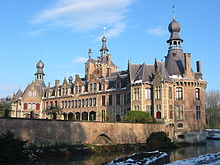Ooidonk Castle
Ooidonk Castle is a moated castle in Renaissance style near one of the many bends of the river Lys in the vicinity of the place Bachte-Maria-Leerne in the town of Deinze , near Gent in the province of East Flanders , which the Flemish region of Belgium belongs.
history
Originally there was a fortification founded in 1230 at the site of today's moated castle . It was part of a defensive ring around the city of Ghent in the 18th century and was used to secure the Leie river. It belonged to the property of Nikolaas van Hoenduncs, Lord of Nevele. Jean de Fosseux had this early castle strengthened as the Nevele moated castle from 1381, after Ludwig III. , Count of Flanders , had been destroyed. Four towers were erected, the north and east towers connected with castle walls. A drawbridge allowed access to the castle .
In the early 15th century, the castle came into the possession of the French noble family Montmorency through the marriage of Jeanne de Fosseux to Jean de Montmorency . Their descendants formed the Flemish branch line Montmorency-Nivelle. Due to the involvement of this noble family in the turbulence of the wars of religion , the castle suffered several times. In 1491 the castle was burned down by the troops of Maximilian of Austria and rebuilt by the owners in 1501.
Philippe II. De Montmorency-Nivelle , son of Joseph de Montmorency, Seigneur de Nivelle († 1530), and Anna von Egmond , was probably born in 1526 at Ooindonk Castle. After his father's death, his mother married Count Jan van Hoorn, who adopted the children. Philippe, better known as Count Hoorn , later opposed Spanish rule in the Netherlands and was eventually executed in Brussels in 1568.
During a siege , the castle was burned down again in 1579 and finally sold in 1595, after 160 years in the Montmorency family.
The owner was a wealthy Antwerp banker named Maarten della Faille, who had the early medieval castle converted into a representative country house in the Flemish-Spanish style in this way the present castle was built. The exterior view, especially the towers, the stepped gables and the many chimneys, are reminiscent of Loire castles as in Chambord . For 200 years, Ooidonk Castle was owned by his descendants, the Barons of Nevele.
In 1864, Count Henri t'Kint de Roodenbeke-de Naeyer (1817–1900), President of the Belgian Senate, came into the possession of the current owner family. The new owner commissioned the French architect Clément Parent (1823-1884) from 1870 to carry out an extensive restoration of the castle in order to adapt it to the increased demands on living comfort. The work essentially concentrated on the interior design, the exterior of the castle remained unchanged.
The castle and the 140 hectare property have been open to the public since 1958 . It is privately owned by Count Juan t 'Kint de Roodenbeke.
literature
- Yvonne Crokaert (Ed.): Ooidonk (Onder kastelen van Oost-Vlaanderen; Vol. 2). Ghent 1973.
- Noël Kerckhaert: 400 jaar Ooidonk . Snoeck-Ducaju, Gent 1995, ISBN 90-5349-162-7 .
- Gérard Rousset-Charny: Le château d'Ooindonk . In: L'œil (1984), No. 348/349, pp. 38-43, ISSN 0029-862X
Web links
- Site of the castle
- Flemish castles "Ooidonk" (French)
- Belgian castles "Ooidonk" (English)
Coordinates: 51 ° 0 ′ 4.7 " N , 3 ° 35 ′ 0.6" E


